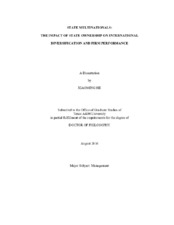| dc.description.abstract | State multinationals were investigated in the 1980s. Since then, little work on the state multinational has been done because of the dramatic changes in the world in terms of both politics and economics, such as the waves of liberalization, deregulation and privatization. However, in the current global environment, we see the increase in the number of state multinationals, and thus initiate research of this study.
This study investigates two sets of research questions. First, is the state multinational the overlap of two organizational forms (the state owned enterprise (SOE) and the multinational enterprise (MNE))? If so, what are the key characteristics and implications of the state multinational? Second, can the state multinational be considered a hybrid organizational form, which is different from that of its parents? Propositions are set forth to examine the first set of research questions. After clarifying the unit of analysis for this study, the second set of questions asks how state ownership influences the state multinational‘s international diversification and firm performance, and what is the impact of institutional ownership on the state ownership—international diversification relationship, and how home country institutional environments influence the proposed relationships. Hypotheses are proposed to investigate the second set of research questions and are tested with a three-year sample (2004-2007) and a seven year sample (2000-2007) of the state multinational.
Results of hierarchical linear models indicate that the state multinational, first, does have characteristics that are different from its parents (i.e., the SOE and the MNE) and thus is considered a hybrid organizational form. Second, state ownership may improve the level of the state multinational‘s international diversification, but reaches a threshold, after which the positive influence diminishes due to the prominent agency costs. Third, institutional ownership has been verified as a useful mechanism to improve the effectiveness of corporate governance in the case of the state multinational. Fourth, home country institutional environments matter in the studied relationships. The state multinational in developed countries with an established institutional environment may not depend on state ownership as much as those in developing and emerging countries.
Results also show the influence of state ownership on the state multinational‘s firm performance. The state ownership—performance relationship is also non-linear (inverted U-shaped). Moreover, in the case of the state multinational, the higher the level of international diversification, the higher the firm performance. In addition, international strategies of the state multinational function as a mediator for the relationship between state ownership and firm performance. | en |


